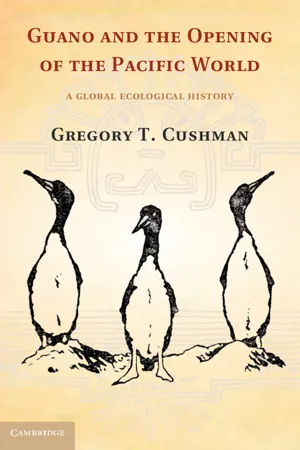
- English
- PDF
- Available on iOS & Android
About this book
For centuries, bird guano has played a pivotal role in the agricultural and economic development of Latin America, East Asia and Oceania. As their populations ballooned during the Industrial Revolution, North American and European powers came to depend on this unique resource as well, helping them meet their ever-increasing farming needs. This book explores how the production and commodification of guano has shaped the modern Pacific Basin and the world's relationship to the region. Marrying traditional methods of historical analysis with a broad interdisciplinary approach, Gregory T. Cushman casts this once little-known commodity as an engine of Western industrialization, offering new insight into uniquely modern developments such as environmental consciousness and conservation movements; the ascendance of science, technology and expertise; international relations; and world war.
Frequently asked questions
- Essential is ideal for learners and professionals who enjoy exploring a wide range of subjects. Access the Essential Library with 800,000+ trusted titles and best-sellers across business, personal growth, and the humanities. Includes unlimited reading time and Standard Read Aloud voice.
- Complete: Perfect for advanced learners and researchers needing full, unrestricted access. Unlock 1.4M+ books across hundreds of subjects, including academic and specialized titles. The Complete Plan also includes advanced features like Premium Read Aloud and Research Assistant.
Please note we cannot support devices running on iOS 13 and Android 7 or earlier. Learn more about using the app.
Information
Table of contents
- Contents
- Illustrations and Tables
- Preface
- Abbreviations and Acronyms
- Prologue
- 1 Introduction
- 2 The Guano Age
- 3 Neo-Ecological Imperialism
- 4 Where Is Banaba?
- 5 Conservation and the Technocratic Ideal
- 6 The Most Valuable Birds in the World
- 7 When the Japanese Came to Dinner
- 8 The Road to Survival
- 9 Guano and the Blue Revolution
- 10 Conclusion
- Select Bibliography
- Index